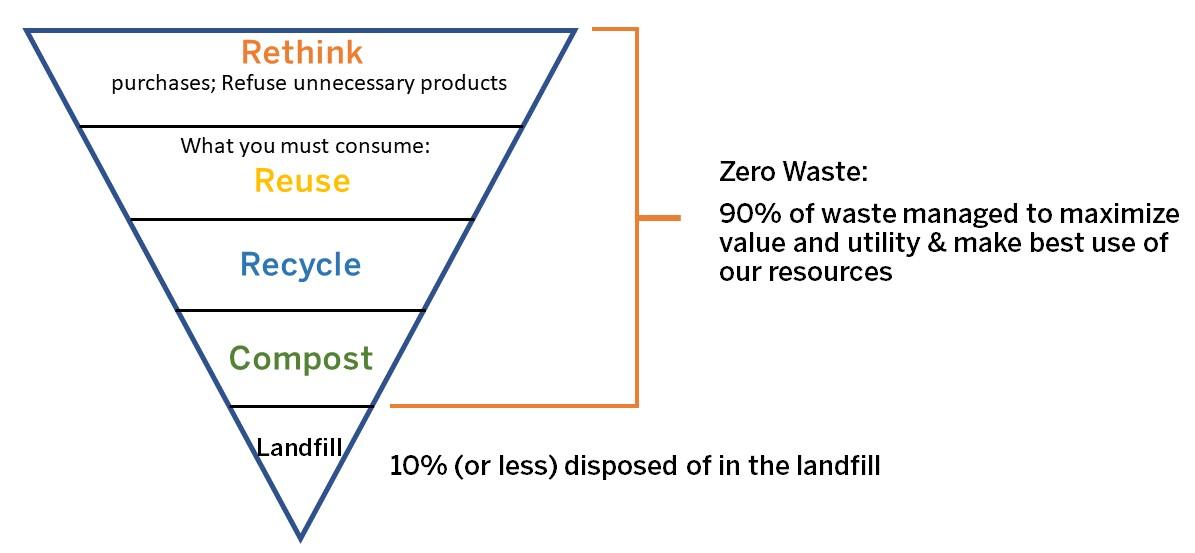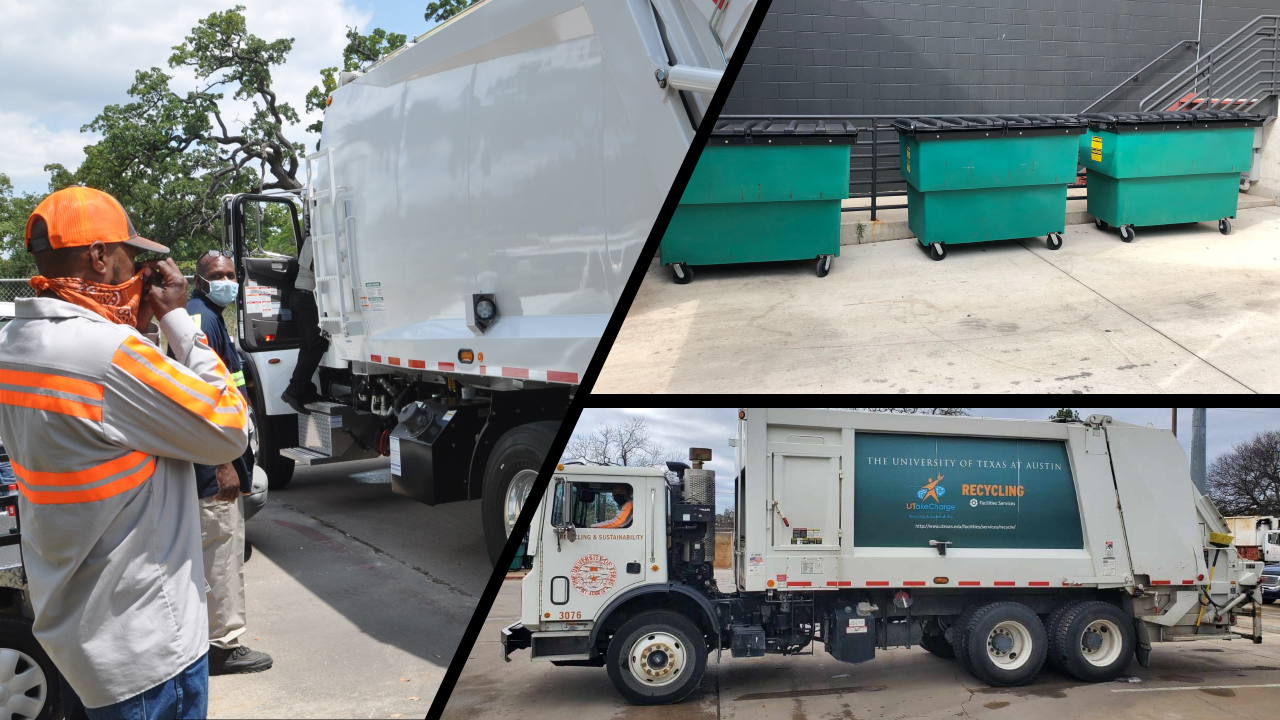What is Zero Waste?
The Resource Recovery branch is responsible for the efficient reuse and redistribution of campus resources and manages our Zero Waste Program. It also supports the campus in the implementation of programs to achieve UT Austin's Zero Waste Goal as stated in the Sustainability Master Plan (PDF).
Zero Waste is the 90% reduction of waste being sent to the landfill through both upstream (pre-consumer) and downstream (post-consumer) efforts. Achieving Zero Waste upstream can mean reducing the amount of disposable products purchased or changing food and shipping packaging. Achieving Zero Waste downstream can mean diverting materials to a recycling or compost facility instead of the landfill.
Goal
The University has a goal to demonstrate leadership in both the reduction and diversion of waste with anticipated outcomes including achieving Zero Waste and reducing per-capita waste generation.
Current Diversion Rate: The 2023-2024 Fiscal Year diversion rate for campus was 34%.
Benefits
The environmental benefits of Zero Waste include:
- Resource and energy conservation
- Waste and pollution reduction
- Greenhouse gas reduction

The waste hierarchy establishes priorities in sustainable materials management from most favorable to least favorable actions. Focusing on the upper tiers of the hierarchy has the largest potential for sustainable impact since end-of-life management is the weakest lever for change. The burden on disposal systems can be reduced through strategies such as reducing consumption as well as product redesign in order to reduce product toxicity and wasteful packaging as well as ensure compatibility with end-of-life diversion through recycling or composting. Waste reduction reduces our carbon impact. Learn strategies to work zero waste on campus and live zero waste in Austin.
Quick Resources
Student Guide to Sustainable Living: Consumption & Waste
One of the five Core Values of Facilities Services is stewardship. As stewards of the University's facility-related services, we strive to conduct our business in an environmentally, socially, and economically responsible manner.
Facilities Services actively reduces consumption, recycles, protects the environment, and restores resources in our day-to-day operations. We also support other campus community sustainability efforts.
Visit these pages to learn more about Facilities Services sustainability activities:
- Tree Conservation initiatives, which include tree moves as part of green building projects
- Building Optimization - How we restore buildings' heating, ventilation, and air conditioning systems to operate as originally designed
- Recycling - What we do to recycle materials, equipment, and other resources
- Partners
About Solid Waste & Recycling on Campus
Our Solid Waste & Recycling team removes approximately 3,500 tons of landfill trash, recyclables, and compostable materials each year from UT's Main Campus. The Solid Waste & Recycling team also supports major events occurring on campus.
- All solid waste, recycling, and compost pick-ups are done at designated outdoor enclosures throughout campus.
- Main Campus solid waste and recycling are picked up in separate trucks Monday-Friday from 4:30 a.m. to 1 p.m.
- Compost is picked up from participating locations on Tuesdays and Thursdays.
- To request solid waste, recycling, or compost pick-ups for a special event and after-hour needs (for example, a football game, baseball game, or South Mall event), complete and submit a request online through UT Works, or submit an Event Planning Request form.
- COMING SOON: Solid Waste & Recycling Terms & Conditions.

Reducing Our Waste
Recycling is serviced single-stream. All accepted plastic bottles and containers*, office paper, cardboard, metal, and glass are collected together.
*Liquids and food of any kind (including water) must be emptied prior to placing in a recycling container.
Compost is serviced from participating locations. For more tips, resources, and FAQs about our campus waste reduction programs see our Zero Waste Program.
For other indoor bin guidance, see our campus bin standards. As part of the Zero Waste Workplace program, Resource Recovery has limited quantities of desk-side and common area-sized blue recycling bins available by request. Contact the team with the requested quantity and size of bins, and we will see if we can accommodate you.
What does not go in the trash?
For information about where an item should go, visit our recycling, specialty recycling, compost, or surplus property pages. Or you may contact the Facilities Services Center at 512-471-2020 or facilities@austin.utexas.edu.
Please note that some materials do not belong in the waste bin. Help us protect our staff and equipment by disposing of these materials properly in the designated locations.
Some common items to avoid placing in campus bins are (Common items SWR CANNOT safely pick up (.docx)):
1. Oversized or bulky items such as:
- Appliances
- Furniture
- Plate glass
- Tires
- Scrap metal
- Metal shavings
- Pipes of any type
- Angle iron of any size
NOTE: a 40-yard roll-off dumpster in the Facilities Complex is dedicated for scrap metal. Campus customers may use this dumpster to dispose of scrap metal.
2. Prohibited items:
- Bricks
- Blocks of concrete
- Pieces of steel
- Cables and wires
- Construction waste
- Lumber (e.g., 2x4s, plywood, etc.)
- Sheetrock
- Carpet
- Ceiling tiles
- Rocks, dirt, fill material
- Paint and aerosol cans
- Chemicals of any kind
- Computers or computer parts
- Fluorescent light bulbs
- Hazardous waste
- Biologically active materials
- Radioactive materials
- Animal or human waste
NOTES:
Pallets may be stacked neatly inside or next to any dumpster corral, and Solid Waste & Recycling staff will remove them with a paid service request, available from UT Works.
Cables and wires disposal: Solid Waste & Recycling staff will dispose of them with a paid service request, available from UT Works, or they can be self-hauled to the Austin Metal Recycling roll-off.



